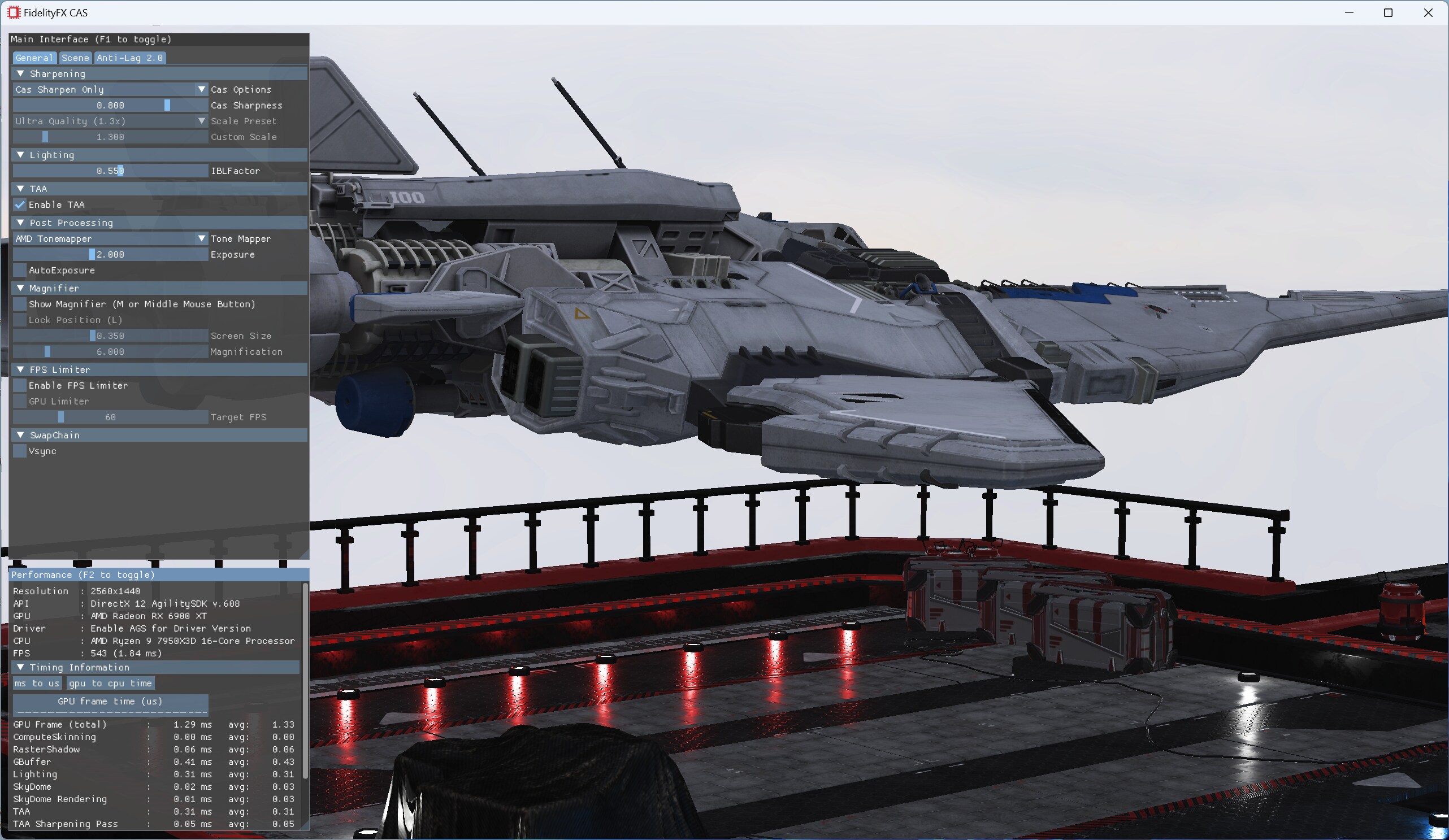FidelityFX Contrast Adaptive Sharpening

This sample demonstrates the use of the FidelityFX Contrast Adaptive Sharpening (CAS) post process effect.
For details on the techniques that underpin the CAS effect you can refer to the respective technique documentation.
Requirements
- Windows
- DirectX(R)12
- Vulkan(R)`
UI elements
The sample contains various UI elements to help you explore the techniques it demonstrates. The table below summarises the UI elements and what they control within the sample.
| Element name | Value | Description |
|---|---|---|
| Cas Options | Upsample, Sharpen, Off | If Off then disables use of contrast adaptive sharpening shader. If Upsample then CAS shader will sharpen and upsample from the selected ‘Render Dim’ to the display resolution as specified by the JSON configuration file (see above). |
| Cas Sharpness | 0..1 | Sliding left of right controls the amount of sharpening (0 - least amount, 1 - max amount). |
| Scale Preset | Ultra Quality, Quality, Balanced, Performance, Ultra Performance, Custom | Combo preset selection. Affect upscale ratio. |
| Custom Scale | 1..3 | Sliding left of right controls the amount of scaling (1 - least amount, 3 - max amount). Note that custom scale preset must be enabled to use the custom scale slider. |
Setting up CAS
The Contrast Adaptive Sharpening (CAS) sample takes as input the color buffer produced by the geometry rendering passes, including the opaque, transparent, and sky box geometry, and also any post processing passes, but before any UI elements are rendered. The CAS shader also has some uniform parameter inputs const0 and const1 which are passed as input to the shader function CasFilter, which is defined in ffx_cas.h.
The value of these constants are computed either on the CPU (preferred) or the GPU by calling the function CasSetup, defined in the same file. The output of the CAS shader is an image of the same or larger dimensions as the input image. The valid dimensions for the output image is a function of the input image’s dimensions and can be determined by calling the function CasSupportScaling (see comments in ffx_cas.h for more details on all these functions).
The ffx_cas.h header file is designed to be included from both C++ and HLSL/GLSL via #define macros (see below).
C++:
#define FFX_CPU#include <gpu/ffx_core.h>#include <gpu/ffx_cas.h>HLSL:
#define FFX_GPU#define FFX_HLSL#include "ffx_core.h"#include "ffx_cas.h"GLSL:
#define FFX_GPU#define FFX_GLSL#include "ffx_core.h"#include "ffx_cas.h"Note that ffx_cas.h is dependent on ffx_core.h, so both must be included.
Shader options
The CAS shader or more specifically the CasFilter function has a few different options. One option is support for using 16-bit floating point (FP16) math versus 32-bit floating point (FP32) math. In general, FP16 math is more efficient than FP32 math on AMD hardware. Another option is the ability to produce upscaled output or to only sharpen the output without upscaling. For best performance, the sample compiles these options into the multiple shader permutations and chooses the specific permutations of the shader at runtime depending on the sample’s current configuration (see UI Elements section above). In all there are four permutations of the shader:
- FP16-sharpen-only
- FP16-sharpen-and-upscale
- FP32-sharpen-only
- FP32-sharpen-and-upscale
Sample controls and configurations
For sample controls, configuration, and FidelityFX Cauldron Framework UI element details, see Running the samples.